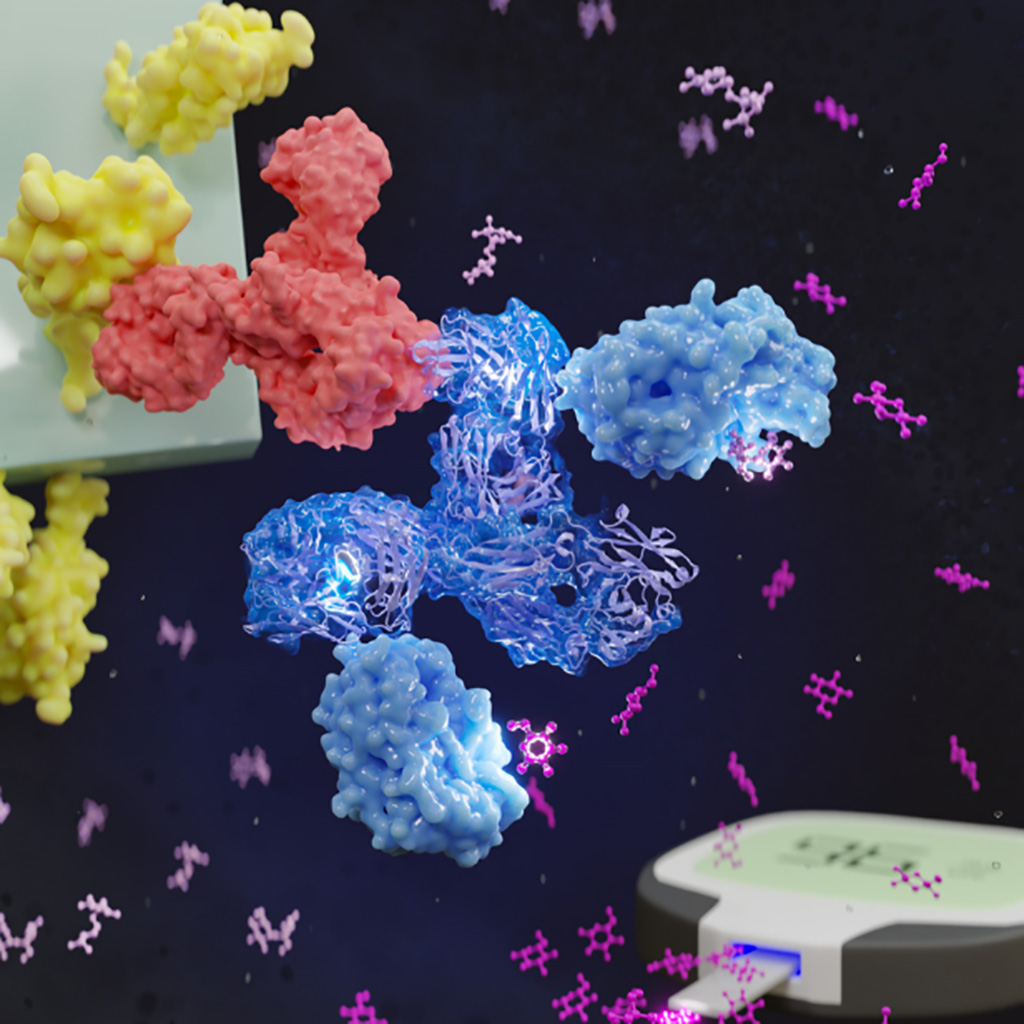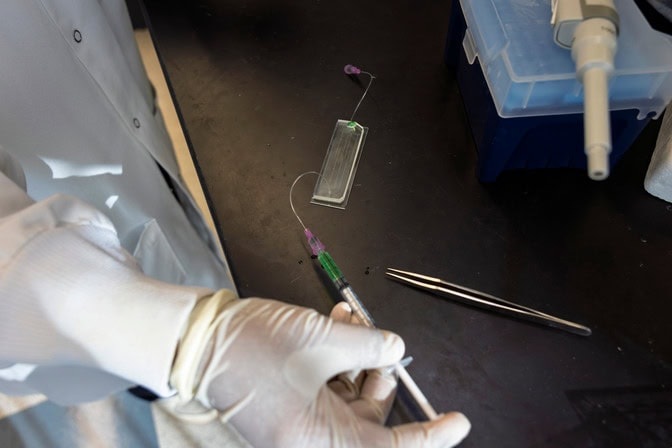Glucose-Based Test Detects Range of COVID Variants
|
By LabMedica International staff writers Posted on 05 Aug 2022 |

With the focus shifting from COVID-19 infections to immunity, people need to know how protected they are against the illness. Now, that information could be right at their fingertips, literally. A team of scientists has found a way to use common glucose meters, like the ones that many people with diabetes use, to measure the level of COVID-19 antibodies a person has in their blood. Antibodies are proteins created in response to a disease, and remain in the body to fight the next encounter.
Currently, to get a COVID-19 antibody test, people have to get their blood drawn at a health care facility. But scientists at Johns Hopkins University (Baltimore, MD, USA) wanted to create a test that was more affordable, accessible and easy to use that would also help people and policymakers make more informed decisions about mask-wearing, booster vaccinations and public safety measures. They chose a glucose meter as the detection device because many pharmacies across the country sell them fairly inexpensively, unlike the expensive equipment many health care facilities must use to measure antibody levels. It also gives a digital readout, making the results easy to interpret.
The scientists are trying to simplify the test for commercial use. But the process aligns closely with how people with diabetes use the glucose meter. The researchers coated the “spike” protein from SARS-CoV-2, the virus that causes COVID-19, onto a glucose monitoring test strip that they designed. The first step is to add a drop of blood to the strip. Spike protein-targeted antibodies from the blood then bind to the strip. Next, the strip is dipped into an enzyme bath, where the enzymes and antibodies bind. Then, the strip is dipped into a new solution full of the sugar sucrose, and the enzyme breaks the sucrose down into glucose. Finally, the glucose meter tests for glucose, which is proportional to the level of COVID-19 antibodies.
In the past, glucose meters have been studied as a means for measuring other chemicals besides sugar. But previous studies ran into a common problem. The challenge was to make a protein that could simultaneously measure the number of antibodies and convert the signal into glucose, so it could then be measured by the glucose meter. To do this, they merged the antibody and enzyme chemically, but the efficiency of the process was too low to be scalable to population-level screening. Instead of merging the two proteins chemically, the team realized they needed to merge them genetically into a new protein.
In a recent study, the researchers tested serum samples from at least six people who had COVID-19 and were undergoing treatment and at least six people who tested negative for the virus. The team found that the glucose-based test was on par with the gold-standard detection method used at health care facilities, pharmacies and testing sites, specifically the enzyme-linked immunosorbent assay (ELISA). The investigators tested the same samples with the glucose monitor test and the industry standard test. They observed a 95% positive and a 96% negative agreement. This means the two tests showed very similar results when testing for samples that were positive and negative for COVID-19.
The researchers have obtained a provisional patent and are reaching out to biotechnology companies to commercialize the technology. However, the researchers want to see what else the glucose-based test can do first. The test not only works for a range of COVID variants but also, potentially, for any disease that produces antibodies in the blood. All they need to do is switch the disease’s correlating protein on the test strip. The team is planning on doing additional studies to simplify the test’s process and analyze its versatility.
“We created something new, something that is not biologically existent in the world right now,” said Netz Arroyo, Ph.D., assistant professor of pharmacology and molecular sciences, one of the inventors of the new approach. “We still think we can improve the reagent and do more with it, and so a part of the process we’re undergoing right now is to see if we can make it even better. And the better we make the reagent, the more commercial interest we’ll get.”
Related Links:
Johns Hopkins University
Latest COVID-19 News
- New Immunosensor Paves Way to Rapid POC Testing for COVID-19 and Emerging Infectious Diseases
- Long COVID Etiologies Found in Acute Infection Blood Samples
- Novel Device Detects COVID-19 Antibodies in Five Minutes
- CRISPR-Powered COVID-19 Test Detects SARS-CoV-2 in 30 Minutes Using Gene Scissors
- Gut Microbiome Dysbiosis Linked to COVID-19
- Novel SARS CoV-2 Rapid Antigen Test Validated for Diagnostic Accuracy
- New COVID + Flu + R.S.V. Test to Help Prepare for `Tripledemic`
- AI Takes Guesswork Out Of Lateral Flow Testing
- Fastest Ever SARS-CoV-2 Antigen Test Designed for Non-Invasive COVID-19 Testing in Any Setting
- Rapid Antigen Tests Detect Omicron, Delta SARS-CoV-2 Variants
- Health Care Professionals Showed Increased Interest in POC Technologies During Pandemic, Finds Study
- Set Up Reserve Lab Capacity Now for Faster Response to Next Pandemic, Say Researchers
- Blood Test Performed During Initial Infection Predicts Long COVID Risk
- Low-Cost COVID-19 Testing Platform Combines Sensitivity of PCR and Speed of Antigen Tests
- Finger-Prick Blood Test Identifies Immunity to COVID-19
- Quick Test Kit Determines Immunity Against COVID-19 and Its Variants
Channels
Clinical Chemistry
view channel
Noninvasive Blood-Glucose Monitoring to Replace Finger Pricks for Diabetics
People with diabetes often need to measure their blood glucose multiple times a day, most commonly through finger-prick blood tests or implanted sensors. These methods can be painful, inconvenient, and... Read more
POC Breath Diagnostic System to Detect Pneumonia-Causing Pathogens
Pseudomonas aeruginosa is a major cause of hospital-acquired and ventilator-associated pneumonia, particularly in lung transplant recipients and patients with structural lung disease. Its ability to form... Read moreMolecular Diagnostics
view channel
World's First NGS-Based Diagnostic Platform Fully Automates Sample-To-Result Process Within Single Device
Rapid point-of-need diagnostics are of critical need, especially in the areas of infectious disease and cancer testing and monitoring. Now, a direct-from-specimen platform that performs genomic analysis... Read more
Rapid Diagnostic Breakthrough Simultaneously Detects Resistance and Virulence in Klebsiella Pneumoniae
Antibiotic resistance is a steadily escalating threat to global healthcare, making common infections harder to treat and increasing the risk of severe complications. One of the most concerning pathogens... Read moreHematology
view channel
MRD Tests Could Predict Survival in Leukemia Patients
Acute myeloid leukemia is an aggressive blood cancer that disrupts normal blood cell production and often relapses even after intensive treatment. Clinicians currently lack early, reliable markers to predict... Read more
Platelet Activity Blood Test in Middle Age Could Identify Early Alzheimer’s Risk
Early detection of Alzheimer’s disease remains one of the biggest unmet needs in neurology, particularly because the biological changes underlying the disorder begin decades before memory symptoms appear.... Read more
Microvesicles Measurement Could Detect Vascular Injury in Sickle Cell Disease Patients
Assessing disease severity in sickle cell disease (SCD) remains challenging, especially when trying to predict hemolysis, vascular injury, and risk of complications such as vaso-occlusive crises.... Read more
ADLM’s New Coagulation Testing Guidance to Improve Care for Patients on Blood Thinners
Direct oral anticoagulants (DOACs) are one of the most common types of blood thinners. Patients take them to prevent a host of complications that could arise from blood clotting, including stroke, deep... Read moreImmunology
view channel
Blood Test Could Identify Colon Cancer Patients to Benefit from NSAIDs
Colon cancer remains a major cause of cancer-related illness, with many patients facing relapse even after surgery and chemotherapy. Up to 40% of people with stage III disease experience recurrence, highlighting... Read moreBlood Test Could Detect Adverse Immunotherapy Effects
Immune checkpoint inhibitors have transformed cancer treatment, but they can also trigger serious immune-related adverse events that damage healthy organs and may become life-threatening if not detected early.... Read moreMicrobiology
view channel
New UTI Diagnosis Method Delivers Antibiotic Resistance Results 24 Hours Earlier
Urinary tract infections affect around 152 million people every year, making them one of the most common bacterial infections worldwide. In routine medical practice, diagnosis often relies on rapid urine... Read more
Breakthroughs in Microbial Analysis to Enhance Disease Prediction
Microorganisms shape human health, ecosystems, and the planet’s climate, yet identifying them and understanding how they are related remains a major scientific challenge. Even with modern DNA sequencing,... Read morePathology
view channel
AI Tool Simultaneously Identifies Genetic Mutations and Disease Type
Interpreting genetic test results remains a major challenge in modern medicine, particularly for rare and complex diseases. While existing tools can indicate whether a genetic mutation is harmful, they... Read more
Rapid Low-Cost Tests Can Prevent Child Deaths from Contaminated Medicinal Syrups
Medicinal syrups contaminated with toxic chemicals have caused the deaths of hundreds of children worldwide, exposing a critical gap in how these products are tested before reaching patients.... Read more
Tumor Signals in Saliva and Blood Enable Non-Invasive Monitoring of Head and Neck Cancer
Head and neck cancers are among the most aggressive malignancies worldwide, with nearly 900,000 new cases diagnosed each year. Monitoring these cancers for recurrence or relapse typically relies on tissue... Read moreTechnology
view channel
Diagnostic Chip Monitors Chemotherapy Effectiveness for Brain Cancer
Glioblastoma is one of the most aggressive and fatal brain cancers, with most patients surviving less than two years after diagnosis. Treatment is particularly challenging because the tumor infiltrates... Read more
Machine Learning Models Diagnose ALS Earlier Through Blood Biomarkers
Amyotrophic lateral sclerosis (ALS) is a rapidly progressive neurodegenerative disease that is notoriously difficult to diagnose in its early stages. Early symptoms often overlap with other neurological... Read moreIndustry
view channel
BD and Penn Institute Collaborate to Advance Immunotherapy through Flow Cytometry
BD (Becton, Dickinson and Company, Franklin Lakes, NJ, USA) has entered into a strategic collaboration with the Institute for Immunology and Immune Health (I3H, Philadelphia, PA, USA) at the University... Read more

























